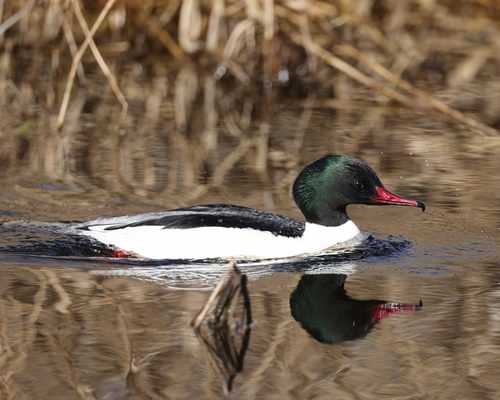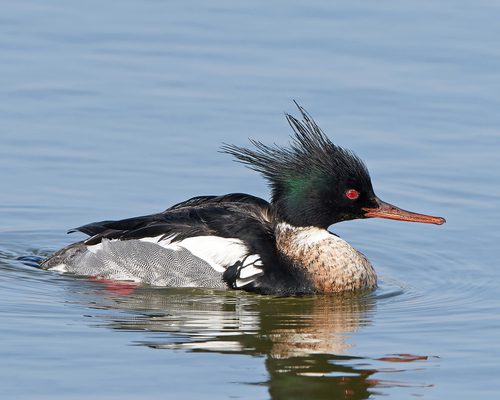Hooded Merganser
Least ConcernLophodytes cucullatus
Visual Identification
Appearance
The Hooded Merganser is a striking duck with a distinctive, fan-shaped crest. Males display a black and white crest, chestnut flanks, and a black back. Their white breast is marked with two black bars.
Females are more subdued, with a cinnamon-colored crest and greyish-brown body. Both sexes have a thin, serrated bill and golden-yellow eyes, which turn bright yellow in breeding males.
Size
Length
40cm to 49cm
Wingspan
61cm to 66cm
Weight
540g to 935g
Habitat and Distribution
Habitats
Woodland
Garden
Wetland
Coastal
Urban
Farmland
Grassland
Desert
Tundra
Rainforest
Mountain
Savanna
Distribution
Hooded Mergansers inhabit forested wetlands, secluded ponds, and slow-moving rivers across North America. They breed in the northern United States and southern Canada, favoring areas with mature trees for nesting.
During winter, they migrate to coastal estuaries and inland waters in the southern United States. Some populations remain year-round in the Pacific Northwest and parts of the eastern United States.
Elevation Range
Up to 1,500 meters
Climate zones
Temperate, Subtropical
Distribution Map
This map gives you a rough idea of where you might spot a Hooded Merganser. The coloured areas show countries where these birds have been seen.
A few things to keep in mind:
- Birds might not be everywhere in the coloured areas, for example, they may be present around the coast of that country
- Where birds live can change with seasons and available food
- This map is quite simple - it doesn't show exact locations
We're working on making our maps even better! Soon, we hope to show you:
- More detailed maps for bigger countries, including state and region
- How birds move around during different seasons
Distribution by Region
Behaviour and Ecology
Bird Attributes
This feature is in beta. We'd love your feedback to improve it!
Share your thoughtsBird Attributes Explained
Our bird attributes system rates various aspects of a bird's capabilities on a scale of 0-100, based on data from field observations, scientific studies, and expert knowledge.
Attribute Categories:
- Agility: Manoeuvrability, speed, and grace in flight or movement.
- Strength: Physical power, often correlating with size and hunting abilities.
- Adaptability: Ability to thrive in various environments or changing conditions.
- Aggressiveness: Territorial behaviour and assertiveness, particularly during breeding seasons.
- Endurance: Stamina, often seen in migration patterns or foraging behaviours.
Understanding the Ratings:
- 0-20: Very Low
- 21-40: Low
- 41-60: Average
- 61-80: High
- 81-100: Very High
Remember, these attributes are relative to other bird species and don't necessarily indicate superiority.
Hover over the icon next to each attribute for more information.
Tap the icon next to each attribute for more information.
Agility
Reflects the bird's manoeuvrability, speed, and grace in flight or movement.
The Hooded Merganser exhibits remarkable agility, particularly in aquatic environments. Their ability to dive and manoeuvre underwater with precision, coupled with their keen eyesight for locating prey, demonstrates high agility. Their capacity to navigate through wooded swamps and perform elaborate courtship displays further supports this rating.
Strength
Indicates the bird's physical power, often correlating with size and hunting abilities.
Whilst not exceptionally strong compared to larger waterfowl, Hooded Mergansers possess moderate strength. Their ability to dive and swim underwater, as well as their capacity to grip slippery prey with their serrated bills, indicates a decent level of strength for their size.
Adaptability
Represents the bird's ability to thrive in various environments or changing conditions.
Hooded Mergansers show good adaptability, inhabiting various environments from forested wetlands to coastal estuaries. Their ability to thrive in both freshwater and marine habitats during different seasons, coupled with their flexibility in nesting sites (tree cavities or nest boxes), demonstrates considerable adaptability.
Aggressiveness
Measures the bird's territorial behaviour and assertiveness, particularly during breeding seasons.
Generally, Hooded Mergansers are not particularly aggressive birds. They become more vocal and display more assertive behaviours during breeding season, but overall, they tend to be relatively peaceful. Their primary focus seems to be on foraging and breeding rather than territorial disputes.
Endurance
Reflects the bird's stamina, often seen in migration patterns or foraging behaviours.
The Hooded Merganser's endurance is quite good, as evidenced by their migratory habits and diving abilities. Their capacity to perform frequent dives for food and to migrate between breeding and wintering grounds suggests a solid level of endurance. However, as short-distance migrants, they don't face the extreme endurance challenges of long-distance migratory species.
Diet
Hooded Mergansers primarily feed on small fish, aquatic insects, and crustaceans. They use their serrated bills to grip slippery prey, diving underwater and swimming with their eyes open to locate food. Occasionally, they also consume plant material, especially during breeding season.
Behaviour
Hooded Mergansers are agile swimmers and divers, using their keen eyesight to locate prey underwater. They often shake their crests when alarmed or during courtship displays.
These ducks are generally quiet but become more vocal during breeding season, especially when performing elaborate courtship rituals.
Vocalisation
Hooded Mergansers are generally quiet but become more vocal during breeding season. Males produce a low, rolling, frog-like croak, often described as 'croo-croo-crrrooo'. Females make a hoarse, guttural 'gak-gak-gak' call, particularly when disturbed or leading young.
Nesting & Breeding
Breeding season for Hooded Mergansers typically begins in late winter or early spring. Males perform elaborate courtship displays to attract females, including head-pumping and crest-raising.
Females select nest sites in tree cavities or nest boxes, often near water. They lay 7-15 cream-colored eggs and line the nest with down. Nests are sometimes shared with other female mergansers or wood ducks.
Incubation lasts about 30 days, performed solely by the female. Ducklings leave the nest within 24 hours of hatching, jumping from heights of up to 50 feet to reach water.
Lifespan
years
The Hooded Merganser typically lives for 10 to 12 years.
Like all birds, lifespan can be affected by factors including predation, habitat quality, disease, and access to food sources.
Conservation and Status
Global Conservation Status
While currently listed as Least Concern, Hooded Mergansers face threats from habitat loss, particularly the destruction of mature forests near wetlands. Conservation efforts focus on protecting nesting habitats and maintaining water quality in their aquatic environments.
Birdwatching Tips
- Look for Hooded Mergansers in wooded swamps and quiet, forested ponds
- Listen for their distinctive, frog-like croaking call during breeding season
- Observe their diving behavior, as they frequently submerge to hunt for food
- In North America, watch for them in winter along coastal areas and unfrozen inland waters
Additional Information
Quick Facts
Other names:
Masked Diver, Hooded Sheldrake, Sawbill
Family:
AnatidaePredators
Main predators include raccoons, minks, and large fish. Birds of prey such as hawks and owls may also target adults and young.
Did You Know?
- Hooded Mergansers can see clearly underwater, thanks to a special membrane that protects their eyes.
- They are one of the few duck species that can breed in their first year of life.
- Their serrated bills, which give them the nickname 'sawbill', help them grip slippery prey.
Was this bird profile helpful?
Your feedback helps us improve our content
Thanks for your feedback!
Your input helps us improve our content.
Community Experience
Community Ratings
No ratings yet - be the first to rate this bird!
Latest Community Reviews
No reviews yet
Sign in to be the first to review
Community Reviews
Create Your Free Account Welcome Back!
Join our community to rate birds and share your experiences. Creating an account is completely free and only takes a minute. Sign in to your account to rate birds and share your experiences with our community.
Your information is secure and will never be shared.
By creating an account, you agree to our Privacy Policy.
Similar Birds
References
- 1
website: BirdLife International. 2021. Lophodytes cucullatus. The IUCN Red List of Threatened Species 2021: e.T22680472A137932133.
View source - 3
report: Meehan et al. 2018; Partners in Flight 2020; Wetlands International 2020
- 2
website, 2020: Partners in Flight
View source

